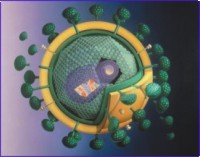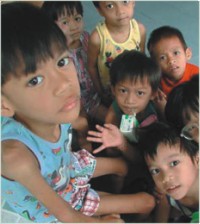AIDS
The Epidemic of Ignorance
By
Prathama Komal Nabi
You
could be next. Yes, you could be the next victim of a merciless monster
that has already taken 33 million lives. It could be you. Then again
it could also be me. The statistics concerning HIV/AIDS are devastating
and the reality even more gruesome. Since the first case diagnosed
in 1980, HIV/AIDS(Human Immunodeficiency virus/Acquired Immuno Deficiency
Syndrome) has infected over 40 million people worldwide, killed 33
million and orphaned a staggering 14 million.
The UN has been working relentlessly to turn the tables and bring
down the numbers. In 1996 the UNAIDS was created to unite six global
agencies in their response to HIV/AIDS, after recognizing the growing
complexities of the global epidemic of HIV/AIDS.
The
basics of HIV/AIDS:
AIDS is the disease that kills and HIV the disease-causing agent.
HIV or the Human Immunodeficiency Virus infects or destroys vital
cells of the body's immune system called helper T-Lymphocytes or CD4
cells. Since these play an integral role in the body's immune system,
the destruction of these cells leads to the eventual failure of the
immune system. This is when AIDS or Aquired Immunodeficiency Syndrome
occurs. In numbers, if the body has less than 200 CD4 cells or if
the percentage is below 14%, the person has AIDS.
However,
the time period varies outrageously from person to person. Some die
within months of being infected while others go on to live healthy,
normal lives. Being infected with HIV is not the same as having AIDS.
After
being infected with HIV as the body's immune system slowly starts
to wear away, the person contracts 'Opportunistic infections'. The
infections are termed as "opportunistic" because these would
not have occurred if the body's immune system was fully functional.
Some opportunistic infections are:
a.
PCP(Pneumocytosis carinii pnuemonia), a lung infection;
b.
KS(Kaposi's sarcoma), a skin cancer;
c.
CMV(Cytomegalovirus), an infection that usually affects the eye;
d.
Candida, a fungal infection
No
cure for AIDS has been found out yet. However, there are drugs that
can slow down the HIV virus, and slow down the damage done to the
immune system.

The
aids virus in action
Transmission
and prevention of HIV/AIDS
One of the main reasons for which HIV/AIDS is spreading like fire
throughout the globe is ignorance of the real facts of its transmission
and prevention. Some are confused, some have very vague ideas, while
some don't even know about HIV/AIDS. Stigma and discrimination concerning
the disease has further fuelled the cloud of unawareness enshrouding
this disease. People are afraid to have any sort of communication
with an infected person, because they think that they will be infected
as well. Because of the contempt and rejection that society shows,
often the infected persons are pushed into isolation and are deprived
of the proper medical treatment.
The
following lists the ways HIV/AIDS is transmitted:
a. Sharing needles, IV drugs with an infected person or being
injured by contaminated needles or other sharp objects.
b.
Using contaminated skin piercing instruments like a tattoo needles,
acupuncture needles, etc.
c.
Receiving blood transfusions from an infected person or infected products,
transplant of an infected organ.
d.
Contact with broken skin i.e., exposure to blood through cuts or lesions.
e.
Transplacental transmission, meaning mother-to-child transmission
during pregnancy or through breastfeeding.
f.
Intercourse or copulation with an infected person.
Contrary
to general misconception HIV/AIDS is not spread through contact, shared
food, clothing, or shaking hands.
As
with all problems the solution lies in its root. Similarly, the prevention
of HIV/AIDS is intertwined with its methods of transmission. The following
precautions can help in restricting the spread of HIV/AIDS-
Using sterilised needles and syringes during blood transfusion, tatooing,
acupuncture, etc. Of course, for drug users the best prevention would
be to stop using drugs.
Taking necessary safety measures while helping someone who is bleeding.
e.g. wearing gloves, face masks and protecting any cuts or opens sores
on the skin.
For those pregnant women infected with AIDS, a special drug AZT is
administered during pregnancy and delivery, which reduces the risk
of having a HIV-infected baby to 2% from a 25% high. The baby itself
is also given AZT.
Implementing proper protection during copulation.
Practicing monogamy and abstinence.

Aids
affected children in Thailand
A
global crisis:
Not a corner of this globe has been spared the wrath of this cataclysmic
scourge. The numbers however vary from region to region.
Africa:
The African countries south of the Sahara, with the some of the best
HIV surveillance systems in the world, estimates that the number of
newly infected adults and children in Africa reached 3.5 million by
the end of 2002. There are now 16 countries in Africa in which more
than one-tenth of the adult population aged 15-24 is infected with
HIV. Horrifying is the fact that in seven countries in the southern
cone of the continent, at least one in five is living with the virus.
This is the highest rate since the epidemic broke out, says the UN
report. With a total of over 5 million infected people South Africa
has the largest number of people living with HIV/AIDS in the world.
Asia:
The largest of the seven continents, Asia continues to struggle through
this epidemic. UNAIDS estimates that 700,000 adults, 450,000 of them
men became infected in South and South-East Asia during the course
of the year 2001. Overall, as of end-2002, the region is estimated
to have 6 million adults and children living with HIV/AIDS.
Eastern
Europe and Central Asia: In countries of the former Soviet
Union, the HIV epidemic continues to be heavily concentrated in injecting
drug users. A conservative estimate of the number of adults and children
living with HIV/AIDS in Eastern Europe and the countries of the former
Soviet Union is 1.2 million in the year 2002.
Caribbean:
HIV is ravaging the populations of several Caribbean island states.
In fact, some of them have worse epidemics than any other country
in the world outside sub-Saharan Africa. Haiti is the worst affected
nation in the region. Overall, around 8%of adults in urban areas and
4% in rural areas are infected with the epidemic. Others, like the
Dominican Republic, has one in every 40 infected with HIV/AIDS, while
the adult prevalence rate in the Bahamas is over 3.5%.
United
Kingdom: An estimated 34,000 people are infected with HIV/AIDS.
However, one in three do not even know that they have been infected.
A
threat close to home: AIDS and Bangladesh:
Hovering over the danger line, Bangladesh stands at low prevalence
with 13,000 infected individuals(UNAIDS report, 2001) of which 4%
are among the IDU(Injectable Drug Users). Globally, reaching 5% in
any high risk group is seen as an epidemic. To avoid an epidemic,
the experts say, Bangladesh needs to work on prevention efforts on
a national level, including increased efforts towards the distribution
of knowledge, promotion of artificial protection, and even behavioural
changes.
World
Aids Day 2003: Live And Let Live:
World AIDS Day was first observed on December 1,1988, after an international
summit of health ministers called for a new spirit of social tolerance
and a greater exchange of information about HIV/AIDS. Observed annually
on December 1st, World AIDS Day serves to strengthen global efforts
to address the challenges of the AIDS epidemic, which is spreading
throughout every region of the world.
Every
year a particular theme is chosen for the World Aids Day and this
year's theme is "Stigma and Discrimination" and the UNAIDS's
slogan this year is "Live and let live".
"Freedom
from discrimination is a fundamental
human right founded on principles of natural
justice that are universal and perpetual. The
basic characteristics of human rights are
that they inhere in individuals because they
are human, and that they apply to people
everywhere." -- UNAIDS
You
can make a difference:
Right this moment HIV/AIDS could be taking down its next victim. This
is where you come in. You can help in saving a life. It's the little
things we all do that add up to make a difference. You can support
the cause by raising awareness of HIV/AIDS in your area, put up posters,
organize a HIV/AIDS campaign, fight stigma and discrimination. Wear
the Red Ribbon*, help make a difference in somebody's life.
*Red
Ribbon-The Red Ribbon is an international symbol of AIDS awareness
that is worn by people all year around to show care and concern aboutt
he issue and to remind others of the need for their support and commitment.
